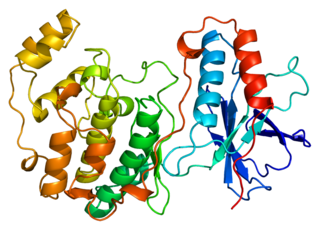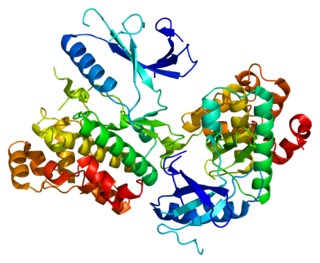Mitogen-activated protein kinase 7 also known as MAP kinase 7 is an enzyme that in humans is encoded by the MAPK7 gene. [5] [6]
Mitogen-activated protein kinase 7 also known as MAP kinase 7 is an enzyme that in humans is encoded by the MAPK7 gene. [5] [6]
MAPK7 is a member of the MAP kinase family. MAP kinases act as an integration point for multiple biochemical signals, and are involved in a wide variety of cellular processes such as proliferation, differentiation, transcription regulation and development. This kinase is specifically activated by mitogen-activated protein kinase kinase 5 (MAP2K5/MEK5). It is involved in the downstream signaling processes of various receptor molecules including receptor tyrosine kinases, and G protein-coupled receptors. In response to extracellular signals, this kinase translocates to the cell nucleus, where it regulates gene expression by phosphorylating, and activating different transcription factors. Four alternatively spliced transcript variants of this gene encoding two distinct isoforms have been reported. [7]
MAPK7 is also critical for cardiovascular development [8] and is essential for endothelial cell function. [9] [10]
MAPK7 has been shown to interact with:
XMD8-92 was one of the first described ERK5 inhibitors and was used in several pharmacological studies as tool compound. However, XMD8-92 hits BRD4 as an off-target [17] leading to false or inconclusive results. Consequently, ERK5 inhibitors with improved selectivity (void of the BRD4 off-target effect) such as AX15836 [17] and BAY-885 [18] were developed and should preferably be used for future pharmacological studies. BAY-885 fulfils the quality criteria for a 'Donated Chemical Probe' as defined by the Structural Genomics Consortium. [19] In 2020, it was demonstrated that ATP-competitive inhibitors paradoxically activate ERK5 signalling. [20]
Based on a close analog of the ERK5 inhibitor BAY-885 [18] the Proteolysis Targeting Chimera [21] (PROTAC) INY-06-061 [22] was developed which allows to compare the phenotypes resulting from ERK5 inhibition versus degradation.
A mitogen-activated protein kinase is a type of protein kinase that is specific to the amino acids serine and threonine. MAPKs are involved in directing cellular responses to a diverse array of stimuli, such as mitogens, osmotic stress, heat shock and proinflammatory cytokines. They regulate cell functions including proliferation, gene expression, differentiation, mitosis, cell survival, and apoptosis.
The MAPK/ERK pathway is a chain of proteins in the cell that communicates a signal from a receptor on the surface of the cell to the DNA in the nucleus of the cell.
p38 mitogen-activated protein kinases are a class of mitogen-activated protein kinases (MAPKs) that are responsive to stress stimuli, such as cytokines, ultraviolet irradiation, heat shock, and osmotic shock, and are involved in cell differentiation, apoptosis and autophagy. Persistent activation of the p38 MAPK pathway in muscle satellite cells due to ageing, impairs muscle regeneration.

RAF kinases are a family of three serine/threonine-specific protein kinases that are related to retroviral oncogenes. The mouse sarcoma virus 3611 contains a RAF kinase-related oncogene that enhances fibrosarcoma induction. RAF is an acronym for Rapidly Accelerated Fibrosarcoma.

Mitogen-activated protein kinase 1, also known as ERK2, is an enzyme that in humans is encoded by the MAPK1 gene.

Mitogen-activated protein kinase 14, also called p38-α, is an enzyme that in humans is encoded by the MAPK14 gene.

Dual-specificity mitogen-activated protein kinase kinase 4 is an enzyme that in humans is encoded by the MAP2K4 gene.

MAP kinase-activated protein kinase 2 is an enzyme that in humans is encoded by the MAPKAPK2 gene.

Dual specificity protein phosphatase 1 is an enzyme that in humans is encoded by the DUSP1 gene.

Dual specificity mitogen-activated protein kinase kinase 6 also known as MAP kinase kinase 6 or MAPK/ERK kinase 6 is an enzyme that in humans is encoded by the MAP2K6 gene, on chromosome 17.

Myocyte-specific enhancer factor 2C also known as MADS box transcription enhancer factor 2, polypeptide C is a protein that in humans is encoded by the MEF2C gene. MEF2C is a transcription factor in the Mef2 family.

Mitogen-activated protein kinase kinase kinase 3 is an enzyme that in humans is encoded by the MAP3K3 gene, which is located on the long arm of chromosome 17 (17q23.3).

Ribosomal protein S6 kinase alpha-1 is an enzyme that in humans is encoded by the RPS6KA1 gene.

Myocyte-specific enhancer factor 2D is a protein that in humans is encoded by the MEF2D gene.

Dual specificity mitogen-activated protein kinase kinase 5 is an enzyme that in humans is encoded by the MAP2K5 gene.

Mitogen-Activated Protein Kinase Kinase Kinase 2 also known as MEKK2 is an enzyme that in humans is encoded by the MAP3K2 gene.

Mitogen-activated protein kinase 6 is an enzyme that in humans is encoded by the MAPK6 gene.

Mitogen-activated protein kinase 4 is an enzyme that in humans is encoded by the MAPK4 gene.

Mitogen-activated protein kinase 15, also known as MAPK15, ERK7, or ERK8, is an enzyme that in humans is encoded by the MAPK15 gene.

MAPK phosphatases (MKPs) are the largest class of phosphatases involved in down-regulating Mitogen-activated protein kinases (MAPK) signaling. MAPK signalling pathways regulate multiple features of development and homeostasis. This can involve gene regulation, cell proliferation, programmed cell death and stress responses. MAPK phosphatases are therefore important regulator components of these pathways.